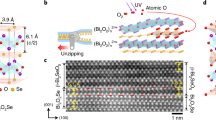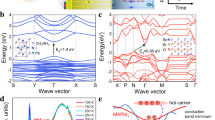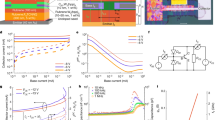Abstract
Bioinspired in-sensor computing devices can process information at sensory terminals by leveraging physical principles, thereby reducing latency and energy consumption during computation while simultaneously enhancing the efficiency of data processing and real-time analysis. Optoelectronic devices exhibit in-sensor computing functions, such as feature enhancement and data compression, by tuning the defect states of the semiconductor channels and thereby modulating the photoresponsivity and time constants of the sensors. These functionalities are critically dependent on precise fabrication and testing protocols. Here we present a detailed procedure for fabricating and characterizing in-sensor computing devices based on nanoscale semiconductor thin films. We explain how to test such optoelectronic devices, including the testing of visual adaptation and motion perception responses. When using semiconductor materials obtained from commercial suppliers, this procedure is time efficient and results in highly reproducible device performance. Nevertheless, all device fabrication and testing steps are generalizable and can be extended to other semiconductor thin films grown using different methods. The procedure is intended for researchers experienced in cleanroom operations and microfabrication techniques and can be completed in ~14 d. The use of bioinspired optoelectronic devices enables the development of a framework for advancing in-sensor computing technologies.
Key points
-
The first section of the procedure details the fabrication of sensors with features for the control of interface defects and quality, which enable the trapping and detrapping of carriers necessary for in-sensor computation.
-
The second section of the procedure details optoelectronic characterizations of the device, including electrical characterization, optoelectronic response characterization and bioinspired in-sensor computing characterization.
This is a preview of subscription content, access via your institution
Access options
Access Nature and 54 other Nature Portfolio journals
Get Nature+, our best-value online-access subscription
$32.99 / 30 days
cancel any time
Subscribe to this journal
Receive 12 print issues and online access
$259.00 per year
only $21.58 per issue
Buy this article
- Purchase on SpringerLink
- Instant access to full article PDF
Prices may be subject to local taxes which are calculated during checkout









Similar content being viewed by others
Data availability
The main data supporting this protocol are available in our previous publications4,5 and can be obtained from the corresponding author upon reasonable request. Source data are provided with this paper.
References
Mennel, L. et al. Ultrafast machine vision with 2D material neural network image sensors. Nature 579, 62–66 (2020).
Chai, Y. In-sensor computing for machine vision. Nature 579, 32–33 (2020).
Sun, L. et al. In-sensor reservoir computing for language learning via two-dimensional memristors. Sci. Adv. 7, eabg1455 (2021).
Liao, F. et al. Bioinspired in-sensor visual adaptation for accurate perception. Nat. Electron. 5, 84–91 (2022).
Chen, J. et al. Optoelectronic graded neurons for bioinspired in-sensor motion perception. Nat. Nanotechnol. 18, 882–888 (2023).
Jang, H. et al. In-sensor optoelectronic computing using electrostatically doped silicon. Nat. Electron. 5, 519–525 (2022).
Zhou, F. & Chai, Y. Near-sensor and in-sensor computing. Nat. Electron. 3, 664–671 (2020).
Wang, Z. et al. Multidimensional vision sensors for information processing. Nat. Nanotechnol. 19, 919–930 (2024).
Yang, Z. et al. A vision chip with complementary pathways for open-world sensing. Nature 629, 1027–1033 (2024).
Chai, Y. Silicon photodiodes that multiply. Nat. Electron. 5, 483–484 (2022).
Pang, X. et al. Non-volatile rippled-assisted optoelectronic array for all-day motion detection and recognition. Nat. Commun. 15, 1613 (2024).
Zhou, F. et al. Optoelectronic resistive random access memory for neuromorphic vision sensors. Nat. Nanotechnol. 14, 776–782 (2019).
Shao, B. et al. Highly trustworthy in-sensor cryptography for image encryption and authentication. ACS Nano 17, 10291–10299 (2023).
Wang, Y. et al. Silver telluride colloidal quantum dot infrared photodetectors and image sensors. Nat. Photonics 18, 236–242 (2024).
Liao, F., Zhou, F. & Chai, Y. Neuromorphic vision sensors: principle, progress and perspectives. J. Semicond. 42, 013105 (2021).
Zhou, Y. et al. Computational event-driven vision sensors for in-sensor spiking neural networks. Nat. Electron. 6, 870–878 (2023).
Ouyang, B. et al. Bioinspired in-sensor spectral adaptation for perceiving spectrally distinctive features. Nat. Electron. 7, 705–713 (2024).
Dodda, A. et al. Active pixel sensor matrix based on monolayer MoS2 phototransistor array. Nat. Mater. 21, 1379–1387 (2022).
Liu, J. et al. A near-infrared colloidal quantum dot imager with monolithically integrated readout circuitry. Nat. Electron. 5, 443–451 (2022).
Mu, G. et al. Visible to mid-wave infrared PbS/HgTe colloidal quantum dot imagers. Nat. Photonics 18, 1147–1154 (2024).
Yang, Y. et al. In-sensor dynamic computing for intelligent machine vision. Nat. Electron. 7, 225–233 (2024).
Jung, D. et al. Highly conductive and elastic nanomembrane for skin electronics. Science 373, 1022–1026 (2021).
Huang, P.-Y. et al. Neuro-inspired optical sensor array for high-accuracy static image recognition and dynamic trace extraction. Nat. Commun. 14, 6736 (2023).
Hong, S. et al. Highly sensitive active pixel image sensor array driven by large-area bilayer MoS2 transistor circuitry. Nat. Commun. 12, 3559 (2021).
Zhang, M. et al. Van der Waals integrated plasmonic Au array for self-powered MoS2 photodetector. Appl. Phys. Lett. 122, 253503 (2023).
Zhang, Z. et al. All-in-one two-dimensional retinomorphic hardware device for motion detection and recognition. Nat. Nanotechnol. 17, 27–32 (2022).
Zeng, G. et al. A solar-blind photodetector with ultrahigh rectification ratio and photoresponsivity based on the MoTe2/Ta:β-Ga2O3 pn junction. Mater. Today Phys. 33, 101042 (2023).
Zhao, Y. et al. High‐electron‐mobility and air‐stable 2D layered PtSe2 FETs. Adv. Mater. 29, 1604230 (2017).
Ng, H. K. et al. Improving carrier mobility in two-dimensional semiconductors with rippled materials. Nat. Electron. 5, 489–496 (2022).
Feng, S. et al. An ultrasensitive molybdenum-based double-heterojunction phototransistor. Nat. Commun. 12, 4094 (2021).
Li, L. et al. Few‐layered PtS2 phototransistor on h‐BN with high gain. Adv. Funct. Mater. 27, 1701011 (2017).
Liu, Y. et al. Promises and prospects of two-dimensional transistors. Nature 591, 43–53 (2021).
Ma, S. et al. Bioinspired in-sensor multimodal fusion for enhanced spatial and spatiotemporal association. Nano Lett. 24, 7091–7099 (2024).
Cao, G. et al. 2D material based synaptic devices for neuromorphic computing. Adv. Funct. Mater. 31, 2005443 (2021).
Wan, T. et al. Neuromorphic sensory computing. Sci. China Inform. Sci. 65, 1–14 (2022).
Wang, T.-Y. et al. Reconfigurable optoelectronic memristor for in-sensor computing applications. Nano Energy 89, 106291 (2021).
Ren, Q. et al. Optoelectronic devices for in-sensor computing. Adv. Mater. 37, 2407476 (2024).
Wan, T. et al. In-sensor computing: materials, devices, and integration technologies. Adv. Mater. 35, 2203830 (2023).
Wang, C.-Y. et al. Gate-tunable Van der Waals heterostructure for reconfigurable neural network vision sensor. Sci. Adv. 6, eaba6173 (2020).
Kwak, D., Polyushkin, D. K. & Mueller, T. In-sensor computing using a MoS2 photodetector with programmable spectral responsivity. Nat. Commun. 14, 4264 (2023).
Wang, Y. et al. Synergies of electrochemical metallization and valance change in all-inorganic perovskite quantum dots for resistive switching. Adv. Mater. 30, 1800327 (2018).
Li, G. et al. Flexible VO2 films for in-sensor computing with ultraviolet light. Adv. Funct. Mater. 32, 2203074 (2022).
Nakamura, M. et al. Shift current photovoltaic effect in a ferroelectric charge-transfer complex. Nat. Commun. 8, 281 (2017).
Yang, M.-M. et al. Bulk photovoltaic effect in monodomain BiFeO3 thin films. Appl. Phys. Lett. 110, 183902 (2017).
Stanciu, C. D. et al. All-optical magnetic recording with circularly polarized light. Phys. Rev. Lett. 99, 047601 (2007).
Xie, D. et al. Photoelectric visual adaptation based on 0D‐CsPbBr3‐quantum‐dots/2D‐MoS2 mixed‐dimensional heterojunction transistor. Adv. Funct. Mater. 31, 2010655 (2021).
Kwon, S. M. et al. Environment‐adaptable artificial visual perception behaviors using a light‐adjustable optoelectronic neuromorphic device array. Adv. Mater. 31, 1906433 (2019).
He, Z. et al. An organic transistor with light intensity-dependent active photoadaptation. Nat. Electron. 4, 522–529 (2021).
Kumar, M., Park, H. & Seo, H. A single‐pixel event photoactive device for real‐time, in‐sensor spatiotemporal optical information processing. Adv. Mater. 37, 2406607 (2025).
Pan, X. et al. Parallel perception of visual motion using light-tunable memory matrix. Sci. Adv. 9, eadi4083 (2023).
Kireev, D. et al. Fabrication, characterization and applications of graphene electronic tattoos. Nat. Protoc. 16, 2395–2417 (2021).
Tang, J. et al. Low power flexible monolayer MoS2 integrated circuits. Nat. Commun. 14, 3633 (2023).
He, X. et al. Strain engineering in monolayer WS2, MoS2, and the WS2/MoS2 heterostructure. Appl. Phys. Lett. 109, 173105 (2016).
Ohta, J. Smart CMOS Image Sensors and Applications (CRC Press, 2017).
Huang, J.-K. et al. High-κ perovskite membranes as insulators for two-dimensional transistors. Nature 605, 262–267 (2022).
Liu, H. et al. Controlled adhesion of ice—toward ultraclean 2D materials. Adv. Mater. 35, 2210503 (2023).
Liao, F. et al. A dual‐gate MoS2 photodetector based on interface coupling effect. Small 16, 1904369 (2020).
Kang, N., Paudel, H. P., Leuenberger, M. N., Tetard, L. & Khondaker, S. I. Photoluminescence quenching in single-layer MoS2 via oxygen plasma treatment. J. Phys. Chem. C. 118, 21258–21263 (2014).
Chen, M. et al. Multibit data storage states formed in plasma-treated MoS2 transistors. ACS Nano 8, 4023–4032 (2014).
Nan, H. et al. Strong photoluminescence enhancement of MoS2 through defect engineering and oxygen bonding. ACS Nano 8, 5738–5745 (2014).
Zhu, C.-Y. et al. Magnesium niobate as a high-κ gate dielectric for two-dimensional electronics. Nat. Electron. 7, 1137–1146 (2024).
Acknowledgements
This work is supported by National Natural Science Foundation of China (grant no. 62425405), MOST National Key Technologies R&D Programme (grant no. SQ2022YFA1200118-04), Research Grant Council of Hong Kong (grant no. CRS_PolyU502/22) and The Hong Kong Polytechnic University (WZ4X and CD9J).
Author information
Authors and Affiliations
Contributions
Y.C. conceived the idea. G.Z., S.M. and H.C. developed the protocol and performed the fabrication and testing. G.Z., S.M., T.W. and J.C. compiled the experimental data. G.Z., T.W. and H.C. designed video supplements. G.Z. and Y.C. cowrote the manuscript. All the authors discussed the results and contributed to writing this manuscript.
Corresponding author
Ethics declarations
Competing interests
The authors declare no competing interests.
Peer review
Peer review information
Nature Protocols thanks Wenzhong Bao and the other, anonymous, reviewer(s) for their contribution to the peer review of this work.
Additional information
Publisher’s note Springer Nature remains neutral with regard to jurisdictional claims in published maps and institutional affiliations.
Key references
Liao, F. et al. Nat. Electron. 5, 84–91 (2022): https://doi.org/10.1038/s41928-022-00713-1
Chen, J. et al. Nat. Nanotechnol. 18, 882–888 (2023): https://doi.org/10.1038/s41565-023-01379-2
Supplementary information
Supplementary Video 1
Visual aid for Step 12 of the Protocol—scratching four corners and pressing thermal release tape.
Supplementary Video 2
Visual aid for Step 14 of the Protocol—separating the sample and rinsing thermal release tape.
Source data
Source Data Box 1–4 images and Source Data Fig. 4–9
Statistical source data 1.
Rights and permissions
Springer Nature or its licensor (e.g. a society or other partner) holds exclusive rights to this article under a publishing agreement with the author(s) or other rightsholder(s); author self-archiving of the accepted manuscript version of this article is solely governed by the terms of such publishing agreement and applicable law.
About this article
Cite this article
Zeng, G., Ma, S., Wan, T. et al. Fabrication and characterization of optoelectronic in-sensor computing devices. Nat Protoc (2025). https://doi.org/10.1038/s41596-025-01262-5
Received:
Accepted:
Published:
DOI: https://doi.org/10.1038/s41596-025-01262-5



